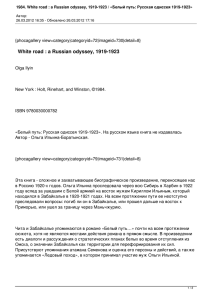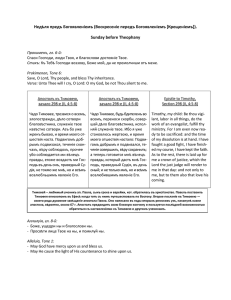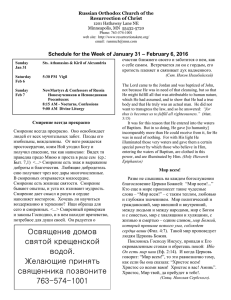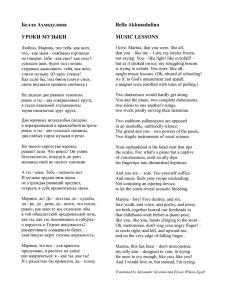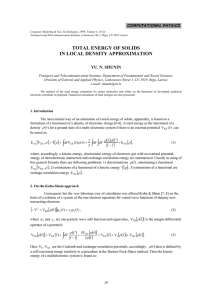Расписание 15-21 марта 2015.
реклама
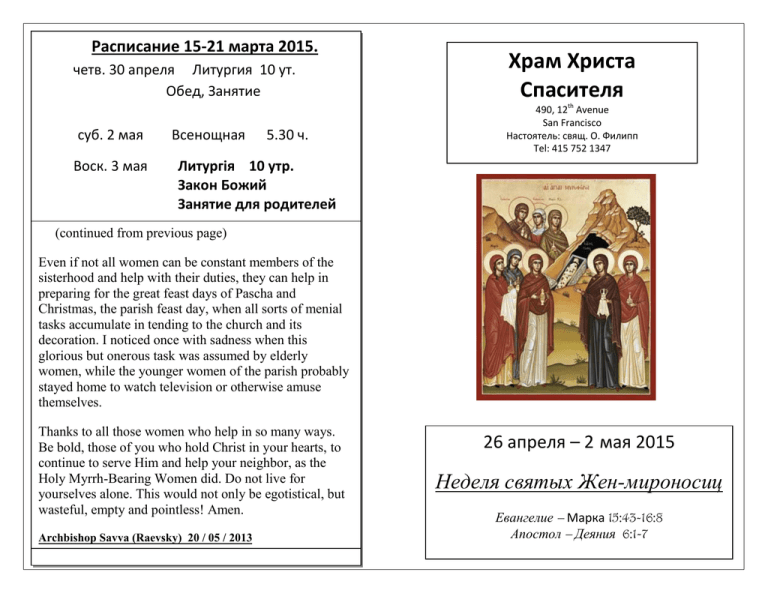
Расписание 15-21 марта 2015. четв. 30 апреля Литургия 10 ут. Обед, Занятие суб. 2 мая Воск. 3 мая Всенощная 5.30 ч. Храм Христа Спасителя P 490, 12th Avenue San Francisco Настоятель: свящ. О. Филипп Tel: 415 752 1347 Литургiя 10 утр. Закон Божий Занятие для родителей (continued from previous page) Even if not all women can be constant members of the sisterhood and help with their duties, they can help in preparing for the great feast days of Pascha and Christmas, the parish feast day, when all sorts of menial tasks accumulate in tending to the church and its decoration. I noticed once with sadness when this glorious but onerous task was assumed by elderly women, while the younger women of the parish probably stayed home to watch television or otherwise amuse themselves. Thanks to all those women who help in so many ways. Be bold, those of you who hold Christ in your hearts, to continue to serve Him and help your neighbor, as the Holy Myrrh-Bearing Women did. Do not live for yourselves alone. This would not only be egotistical, but wasteful, empty and pointless! Amen. Archbishop Savva (Raevsky) 20 / 05 / 2013 26 апреля – 2 мая 2015 Неделя святых Жен-мироносиц Евангелие – Марка 15:43-16:8 Апостол – Деяния 6:1-7 Иеромонах Макарий (Маркиш), преподаватель ИвановоВознесенской духовной семинарии (г. Иваново-Вознесенск): – Женскую природу, как, впрочем, и мужскую, невозможно свести к какому-то одному «решающему» признаку. Мы лишь наблюдаем живую, непосредственную реальность: Сын Божий принял природу человека в ее мужском качестве, будучи рожден в этот мир женщиною... Женская природа обладает особыми дарами в сравнении с мужскою. Деторождение – лишь один из них. Женщина живет на этой земле в среднем на 10–15 лет дольше мужчины, а преступлений совершает в 10– 15 раз меньше. И всё почему? Потому что она гармоничное существо, а мужчина – противоречивое. Ведь все мы, независимо от нашей анатомии и физиологии, невесты Христовы; все мы – приемлющая сторона перед Лицом Единого Подателя всех благ. И недаром геном мужчины содержит две различных хромосомы: мужскую и женскую, а женщины – две одинаковых, женских. Итак, женщина несет с собой (способна нести!) гармонию в этот мир – «любовь, радость, мир, долготерпение, благость, милосердие, веру, кротость, воздержание»... А средоточие гармонии, тот фокус, где достигается единение человека с Господом и людей друг с другом, именуется Церковью. И хотя Церковь одна, но люди различны, различны их земные судьбы. Христов идеал один для всех (как напомнил нам священномученик митрополит Иларион Верейский), но различаются пути к Нему. Есть путь в Большую Церковь напрямую, есть и путь в Большую Церковь через Малую. Первый путь – путь безбрачия; второй – путь семьи. Каждому и каждой из нас свой путь, свой подвиг и своя радость встречи с Господом. Нельзя их путать: «Человек с двоящимися мыслями не тверд во всех путях своих». Ведь на каждом из этих двух благословенных путей женское сердце дарит миру (способно дарить...) неисчерпаемую меру жертвенной любви, в которой нам, как некогда апостолам, открывается воскресший Христос: «Любовь познали мы в том, что Он положил за нас душу Свою: и мы должны полагать души свои за братьев». Today is dedicated to the Holy Myrrh-Bearing Women. This is a great feast day for everyone, but especially for women, Christian women, who like the Myrrh-Bearers sacrifice their time and labor and resources, that is, all they have, for the good of the Church and their neighbor. The Church, brothers and sisters, is the body of Christ, all the member organs of which are in constant contact, endlessly acting and living, and the life of the Church is a vineyard demanding constant care and cultivation. This is how women who hold the Myrrh-Bearers as their ideal cultivate the vineyard. When Christ was born and the shepherds came to worship the Divine Infant, they hear angelic singing! Blessed are the women who take the gift the Lord gave them to the Church, and just like angels praise the Lord in church singing, gaining great pleasure themselves and bringing great joy to the worshipers. Blessed are the women who as members of their parish sisterhood voluntarily and with self-sacrifice take on the noble duty of tending to the good order and adornment of the temple, who care for its vestments, who organize trapeza feasts, tend to the poor, etc. What joy, for instance, have the sisters of our little church here bring to us when on Holy Pascha they provided the white vestments to the clergymen and even the altar boys! This was no mean feat, and their labors, on top of their daily tasks at home, must be appreciated.
